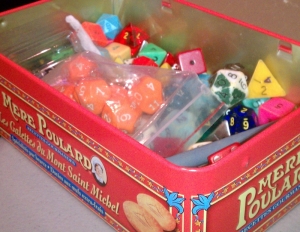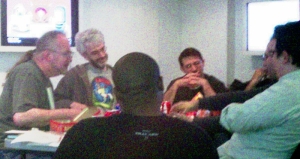This Wednesday we have a double-top-secret, as in we’ll make you sign a NDA before even giving you the second NDA, session of Games that Can’t be Named. Our location for this week, 333 Court Street, is in keeping with the “you get to see it before it’s publicly available” theme. The Brooklyn Strategist is still under construction, but they’re opening their doors early for this event. Owner Jon Freeman says:

What's New with Phil and Dixie. Did you know there were new (as in 'created this millennium') ones of these, and they're all online? Click the picture to check 'em out!
Just so I can set everyone’s expectations at a realistic level, it’s still a construction zone. It won’t have the amazing and cool vibe we’re hoping to achieve in the final product and it’s possible that the place will be a little dusty (plus I won’t have any shelving or counters up – they won’t go in until end of the week). That said, I’m a big proponent of “if you bring good people together with games, food and drink, it usually doesn’t matter where they are…”
Hopefully it doesn’t matter too much what the games are either, because those are also under construction! Only those adventurous souls prepared to trip over an as-yet-unfixed mechanic, an uneven seam in the thinset concrete, or proud nails both literal and figurative need apply.
This Wednesday will be the third installment in the Games that Can’t Be Named series. The next two, 2/8 and 2/15, will be back at the Soho Gallery for Digital Arts at 138 Sullivan St. On those nights we’ll continue to have folks ready to run and play the games from earlier in the series (including the one we’re busting out tomorrow), and will continue to introduce a new not-widely-available game each night.
Here are some things that players in the sessions so far have ventured past the veil of silence to report!
Co-organizer Alex Guzman writes at RPG.net:
We had OSR gamers playing alongside 4e players playing alongside indie gamers all having a good time. It was great validation for my belief that people aren’t looking for the perfect game they are looking for a good time. What our hobby needs isn’t more products its more people to play with. That’s my opinion – but what the hell do I know right? lol
nerdNYC has lots of people daring the fiery wrath of disclosure to talk about the experience. The quotes below from cawshis leave out some great stuff, including more of the saga of his mom playing tabletop games again after 20 years (also referenced at RPG.net):
Happy to have been there for the first one. Hope to make one the next time I’m in town! I should say, despite the logistical considerations, I had a great time and so did my mom, who talked about it all the way home. I was mainly interested in the full “stranger” to the scene experience and that’s what I got! From where I sat, I thought you guys pulled it off. Everyone appeared to be having a fun time and that’s what’s important to me. The format needs only a few tweaks in logistics.
I encourage everyone to go! These kinds of experiments in ad-hoc gaming should be supported and encouraged! It can only improve the more folks go and try it out. And it’s fun gaming with strangers since, as Eppy taught me, it’s all about going out on dates with lots of gamers to find those perfect matches.
The logistics he mentioned were:
- Big groups: we had a larger turnout than expected and wound up with a table that, while not exceptional by White Sandbox standards, had more players in one group than most are used to. Tomorrow we’ll have at least four people ready to GM, with likely group sizes thus in the standard 4-8 range.
- Setting expectations: This is a tough one. The format means there are things that can’t be said; the games are so new that it can be hard to know what they’ll be like; and what part of the experience comes from the GM rather than the material is hard to assess. However, to answer some of jenskot‘s questions for tomorrow’s game, I expect it will be skewed toward combat rather than role-playing (although being player-driven means it could go either way) and a system-matters playtest.
Blogger Tenkar reported on the second session, where we did much better with logistics and solved at least some people’s expectation issues by describing the game as “inspired by OD&D and Burning Wheel and old-school video games”:
It was a blast! I met some really cool gamers, had some excellent Tunnels & Trolls conversations (last thing I expected to find), saw some amazing Old School D&D art from the likes of Peter Mullen (rendered on digital screens) and got some gaming in. I wish I could talk about the RPG I played a session of, but I can’t (NDA and all that). I will say it was a lot of fun and a blast to play.
Lessons learned? I should bring an old notebook, more then 2 sets of dice, gem dice don’t read so well depending on the light at my semi-advanced age and gamers are gamers no matter the age.
Most important lesson? My wife is awesome! Thanks for encouraging me to attend ;)
One game that happened at last week’s session can’t be named only because, when Michael Mornard learned to play it, various people called what they were doing “Blackmoor” or “Greyhawk”. Now that we’ve settled on “original Dungeons & Dragons” as a name, however, both myself and Paul Hughes (here and here) have been eagerly sharing the lore Mike is helping bring out from behind an undesired veil of secrecy.
I’m sad to report that Mike won’t be at tomorrow’s session – seminary school starts this week, making weeknights tough for him although I hope we’ll find another time. However, if you’re in range of Brooklyn, please do come by and help us make some new gaming history!










What People Say to the Mule